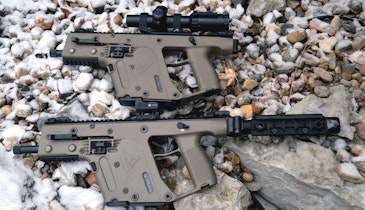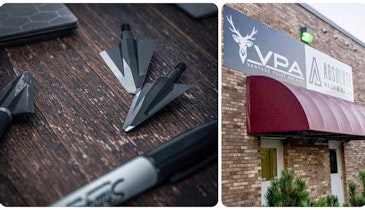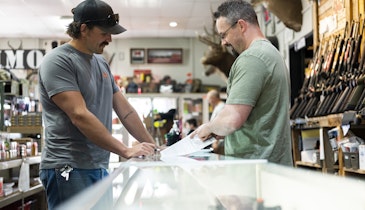As a shooting sports retailer, one of the most common requests you may hear from your clients is for advice on the best finish for their firearm. In addition to advice, they may want you to perform firearm refinishing services. Whether you just give advice, perform the service in-house, or assist your client by shipping and receiving their firearm to and from a professional refinisher, you’ll need to know which finishes best suit your client’s specific needs.
Will the firearm to be refinished be used as a hunting gun, duty gun, military gun or will it be a presentation firearm primarily used for display and normally housed in a climate controlled safe? What is the primary construction material of the firearm to be refinished? Some finishes will be better suited to steal than aluminum, and vice a versa.
Blued Steel
Many people enjoy the look of blued steel because professionally-blued firearms maintain a classical look that many shooters still demand. However, despite its popularity, bluing is not the most durable firearm finish available.
Hot salt solution bluing is commonly applied at warm temperatures between 250 and 350 degrees. Hot bluing generally yields better results than cold bluing. When you combine master grade polishing on steel gun parts and properly apply hot bluing, it can result in a stunning presentation-grade finish.
However, bluing needs to be oiled and maintained in order to preserve the finish. The low durability of bluing causes it not to be the best choice for hard-use firearms. Some traditionalist gun owners — or those who like the worn blue look — will insist on bluing for their firearm’s finish. As long as you caution them about the low durability and poor resistance to corrosion, they will be making an informed decision when they make their final finish choice.
Chrome
When inventive shooters were searching for a firearm finish with more durability than bluing, they started testing hard chrome plating. This finish was referred to as industrial hard chrome and commonly used on saltwater boat propellers. Any finish that could withstand saltwater and high-speed rotation could be a contender as a durable firearm finish. In the late 1960s and through the 1970s, hard chrome plating became popular on firearms.
It was quite common to hard chrome the frame area of a 1911 pistol to protect it against rust and wear caused by a shooter’s perspiration and grip. The slide was commonly left dark blue so that the sighting area would be kept non-reflective. This gave rise to the two-tone, or pinto, 1911 custom pistol. This type of finish is sometimes still requested today based upon the look alone. However when shooters experienced the durability of the hard chrome pistol frame, they soon followed with requests to hard chrome the entire pistol (except for the sights).
The durability factor of industrial hard chrome is light-years ahead of common bluing.
Some people will confuse industrial hard chrome with their experiences with chrome from the automotive industry where was not uncommon for automotive chrome to chip and peel. This was certainly not something shooters would want applied to their firearm.
When properly applied by a professional, true industrial hard chrome does not have the problem of chipping or peeling is not uncommon for industrial hard chrome to have a hardness rating of 65 on the RC scale. In addition to the hardness and durability of hard chrome, it is also possible to polish, brush or matte industrial hard chrome. This gives shooters the option of having a bright shiny gun, a stainless steel-appearing gun or a matte non-reflective light gray firearm color.
Industrial hard chrome can be applied to blued carbon steel firearms or stainless steel firearms. The hard chrome finish can improve the corrosion resistance and durability of blue carbon steel firearms and reduce the galling that often occurs with stainless steel firearms.
It is a win-win situation with both of these types of steels. Overall, industrial hard chrome is a good choice for steel and stainless steel firearms. Hard chroming a well-fitted firearm allows for long-term smooth functioning without galling and very low maintenance.
Nickel Plating
Nickel plating has been applied to firearms for many decades. Don’t confuse nickel plating with industrial hard chrome. Some of your customers may have had poor experiences with nickel plating in the form of flaking or peeling off their firearms.
Keep in mind that nickel plating is only about 40 to 45 on the RC scale compared to industrial hard chrome’s 65 RC rating. You may have to explain to your clients that the two platings have two completely different wear factor ratings, with hard chrome being much better.
Cerakote
The modern firearms market has seen a substantial increase in tactically oriented firearms, so many of your clients may prefer a matte tactical colored finish instead of the silver/gray finish of hard chrome.
There is a solution for this. For example, say you have hard chromed a custom 1911 pistol for a client to give him the best in corrosion resistance and durability. Your client, however, still wants a colored tactical finish. Cerakote is an airbrushed-on over finish that can be purchased in a wide variety of colors to suit almost everyone’s taste. Provided you take into account the tolerances of the firearm that you are working on, you can apply a layer of Cerakote over the top of industrial hard chrome plating. This will give your client the color he is looking for, as well as dual layer corrosion protection.
On hard-use firearms you may eventually wear through the outer colored coating, but you will only arrive at the industrial hard chrome plating; so corrosion will not be a problem. The firearm may have the look of a worn blued firearm, but the silver streaks showing in the wear areas will actually be hard chrome instead of bare steel. There are many different types of over coatings on the market today, but Cerakote is known as a proven performer.
Other Options
For your customers who read up-to-date coverage on other firearm finishes and treatments, they may inquire about nickel boron. Modern nickel boron claims indicate that it is an optimal combination of corrosion and wear resistance and offers hardness and lubricity. Being relatively new to the firearms market, it would be wise to have some test parts finished with this process so they can be thoroughly evaluated before recommending that a customer invest the time and money to coat his firearm with this procedure.
Another similar area that requires more testing and evaluation is bore coatings. A hot topic in the firearms industry is salt bath nitrocarburizing, a process that claims a RC scale rating of 55.
However, the process requires a high-temperature application, so it is only suitable to materials that it can withstand high-temperature processing. It is critical that firearm heat treatment is not affected in a negative way. Do your research before you make any recommendations to your customers.
The firearms market is currently awash with coatings making competing claims of greatness. Physical vapor deposition finishing, vacuum deposited coatings, plasma nitriding and other high-tech sounding processes are going to be some of the things your up-to-date customers are going to be asking you about. One customer recently insisted on finishing his custom pistol with a new finish that was super hyped in a gun magazine article. Not only was the finish over-priced, but it wore off quicker than bluing. Be cautious.
My suggestion is to not recommend anything that you have not personally tested and found acceptable for its expected use. Spend some time separating high-performance coatings from modern snake oil by obtaining and testing samples of any coating that looks to be of interest.
Until you are fully convinced by objective testing that a new product is worthy of your recommendation, stay with long-term tried-and-true firearm finishing processes.





